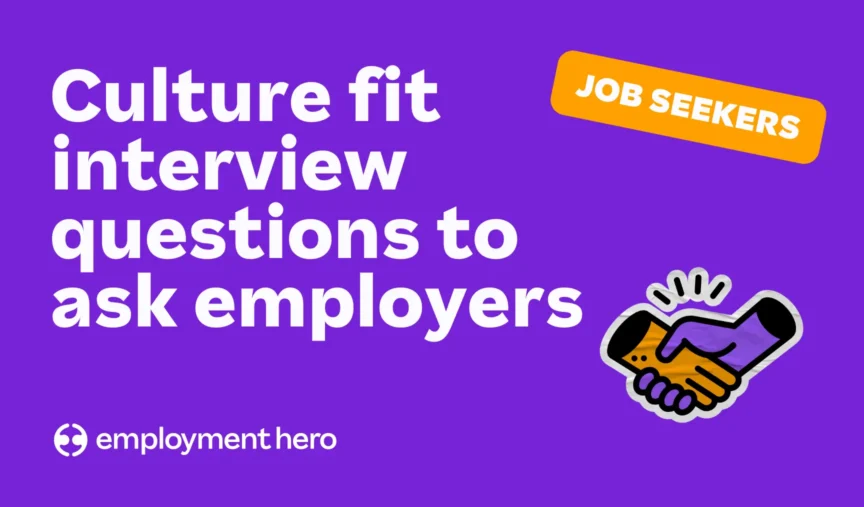Ultimate Guide to Workplace Policies and Procedures [2025]
A well-written and clearly communicated policy helps set clear expectations around employee behaviour and standard workplace procedures. Our complete guide will explain everything you need to know about workplace policies.

Contents
A well-written and clearly communicated policy helps set expectations around employee behaviour and workplace procedures. It ensures that all employees are aware of important rules that need to be followed, and any codes of conduct. Although they sound complicated, workplace policies shouldn’t be mysterious documents that wither away on dusty shelves. Instead, they’re dynamic tools that articulate your organisation’s values, culture, systems and processes. These guidelines and procedures help to framework your organisation’s expectations around your employee’s behaviour. If you’re wondering whether you need clearly defined workplace policies for your workplace, the answer is a definite ‘yes’. In this comprehensive guide, we will go through everything you need to know about workplace policies and procedures.
What are workplace policies and how do I write one?
A workplace policy is a statement which outlines an organisation’s practices and procedures concerning part of its business. These guidelines can cover everything from day-to-day operational matters to compliance with employment legislation. Procedures in the office play an important role in expressing an organisation’s values and establishing a positive and productive culture. Well-written and clearly communicated company procedures help set clear expectations around employee behaviour, which means everyone can get on with business. Workplace policies also safeguard an organisation from risk. According to Employment Hero’s HR Compliance white paper, implementing guidelines will “protect your business from a range of situations, whether it’s social media, inappropriate computer use, discrimination or harassment.” “If you don’t have a policy, then it’s very difficult to defend certain claims that might be brought by an employee,” says Simon Obee, Head of Legal and Professional Services at Employment Hero.
Why should you have workplace policies and procedures?
It can be really frustrating and time-consuming to try and keep up with all the legislation and compliance updates coming your way. Maybe you love them, maybe you hate them, but one thing’s for sure, you can’t live without them. So, why do we have procedures in the workplace? Procedures and policies in the workplace are an essential component of people management for any business. They outline operating processes. Workplace policies also help articulate an organisation’s mission and values and set the standard for employee behaviour and performance.
The importance of workplace policies and procedures
Another question you may be asking is what is the importance of policies and procedures in the workplace? Workplace procedures and policies help to provide a decision-making framework to ensure integrity and fairness are adhered to when issues arise. As well as help minimise legal and safety risks for you and your business. But remember, policies and procedures aren’t interchangeable. Workplace policies communicate the connection between a business’ vision and values and its day-to-day operations. An example of this would be a health and safety policy that aims to reduce fire hazards by not allowing flammable or combustible substances on company property. Workplace procedures explain specific action plans for employees when carrying out a policy. Workplace procedures are important because they tell your employees how to deal with a situation and when. An example of health and safety procedures would be in the event of a building fire, how employees should evacuate from the premises safely.
How can you ensure employees adhere to policies and procedures?
Updating and reviewing policies and procedures in the workplace is key to their success. Therefore regular training sessions with your employees are important to inform and remind them of operational procedures so that they can stay on track. As a business, you could consider updating your processes even when you introduce things like new software or are noticing increased levels of stress amongst employees. Employees who are up to date with their procedures and policies can lead to stronger relationships in the workplace and a better public reputation for your business.
Workplace policy examples
The types of workplace policies that a business requires vary between industries, but here is a list of common organisational policies:
- Code of conduct
- Recruitment policy
- Internet and email policy
- Mobile phone policy
- Non-smoking policy
- Drug and alcohol policy
- Health and safety policy
- Anti-discrimination policy
- Anti-harassment policy
- Grievance handling policy
- Discipline and termination policy
- Social media policy
- Attendance policies
When developing policies, make sure to provide an overview of the policy first, then describe how it operates. It may also be helpful to provide examples of the policy in action. Finally, include a section that details how the policy interacts with your other policies and procedures. Effective and compliant workplace policies can protect a business if disgruntled employees bring a claim against the company. They also help foster a safe workplace by providing employees with options for reporting issues that may arise.
Tips for writing company policies
It’s hard to know where to start when it comes to creating workplace policies. However, it is advisable that any new set of guidelines has the support of management and, where appropriate, consulting with staff in its development and implementation to help encourage buy-in and compliance. If you’re still feeling unsure, here are our top four tips for writing company policies.
1. Clearly define policy terms
A workplace regulation should state its purpose and define key terms to avoid any ambiguity if a breach is made. The document should use easy-to-understand language that is free from jargon. The policy should make clear to whom it applies, what is acceptable and what is unacceptable. Also included should be consequences of non-compliance. It should additionally include a mechanism for reporting issues. Ensure that your policy adheres to any relevant laws and regulations. You may consult a legal professional to ensure your policy is legally compliant.
2. Ensure employees understand company policies
It’s not enough to write a set of guidelines and file it under ‘done’. For guidelines to be effective, they require proper implementation, which means making sure staff are aware of it and its implications. Training in workplace policies should be a mandatory part of the onboarding process, and copies of the policies should be stored in easy-to-find locations.
3. Use a workplace policy checklist
Employment Hero’s HR Compliance white paper sets out a simple five-step checklist for employers:
- Clearly explain the conduct expected of employees and the consequences of breaching guidelines.
- Ensure all employees have easy access to your guideline documents.
- Regularly audit workplace processes to keep them updated with relevant laws and other protocols in your company.
- As part of your onboarding program, ensure all new hires review their awareness and understanding of your workplace policies.
- Where appropriate, conduct regular training on appropriate workplace behaviour.
4. Use resources provided by local legislation offices
The UK Government website offers some other helpful guidance for business owners who need to draft policies and procedures for their workplace. It includes a rundown of relevant legislation and guiding laws in an easy-to-access glossary style. This is a vital part of improving how your customers and staff interact with your overall business operations. It is important that you:
- Identify key processes and tasks and develop standard operating procedures (SOPs) for them.
- Allow staff to contribute to the content and regularly review all processes.
- Make sure all policies are well-documented and accessible.
- Make first-aid and emergency exit procedures clearly visible.
- Communicate all policies with staff, detailing why they are important.
- Educate staff on procedures relevant to their role.
Which policies should you consider adding in 2025?
2025 is all about building inclusive workplaces and work cultures that embrace authenticity and diversity. Even though it’s important, it’s not just about having policies in place in case of legal claims. There’s a need for employers, especially those who want to level up their retention strategy, to empower their employees. The policies you put in place can help you do so. Think of them as ground rules established for you to become an equal opportunity employer. Here are a few key policies you should prioritise having:
Gender-neutral parental leave policy
If your aim is to build an inclusive workplace culture, and you’re still using gender-focused maternity and paternity leave policies, it’s time to pivot. Start by introducing a gender-neutral parental leave policy. Having a gender-neutral parental leave policy means that same-sex partners will be able to apply for parental leave. Some studies see this as a positive step forward towards the gender pay gap. What the policy looks like in action: Coty, one of the largest global beauty powerhouses and the parent company of well-known brands such as OPI, Max Factor and Rimmel created waves when they introduced their gender-neutral parental leave policy late last year. It applied to pregnancy, adoption and surrogacy policies. The brand told the Guardian that they hoped “this change in policy will promote “gender equality in pay” and level the playing field for men and women.”
Employee wellness policy
If your aim is to build a healthy work culture, then an employee wellness policy should be front of mind. Covid has taught us how important work-life balance is – especially if you want to build a successful business that looks after its employees. Get started by paying attention to the top eight workplace wellness trends. Next, make sure you build a holistic workplace wellness program if you haven’t got one already. Finally, ensure that your wellness policy reflects these. What the policy looks like in action: Over in the UK, Allplants is paving the way when it comes to workplace wellness. The vegan food delivery service has health and sustainable values at the core of its product, so it makes a lot of sense that they extend the same ethos to their team. Just a few of our favourite wellness support perks that they provide include; access to mental health support with Spill, a hybrid working model to support flexibility, a £500 yearly learning allowance, a cycle-to-work scheme, parental leave and pregnancy loss support leave. All on top of giving their employees a free monthly delivery of Allplants food.
Flexible working policy
A flexible work arrangement refers to the process that allows employees to have some control over their working hours and where they get work done. As employees strive towards creating a work/life balance, there’s been an increase in the growing demand for a flexible working policy over the last few years. What the policy looks like in action: At Employment Hero, we’re proud of the flexible working policy we’ve put in place. It allows our Heroes to take control over their work hours so that they can also do things such as school runs and carer duties. It works well with the remote first policy we have as it empowers our team to travel the world, too. Haven’t got one in place yet? Use our flexible working policy template to get a head start.
Menstruation leave policy
Menstruation leave, otherwise known as period leave, is a workplace policy that gives people time off while on their period. While those who menstruate may experience different levels of pain when on their period, recent studies have shown that the feeling of severe cramps some experience can be compared to the feeling of a heart attack. What the policy looks like in action: Not too long ago, Spain became the first country in Europe to pass a paid menstrual leave law. While this is good news, employers must take note that not everyone might be comfortable sharing with their employer the reason behind why they want to take leave. Periods are after all, very personal. To respect this, many have instead opted to push for flexible work policies.
AI acceptable usage policy
While AI has been around for a few years, ChatGPT has recently created waves with its ability to empower users to half the time taken to do various tasks across different business areas including HR. If your employees are already using AI, or interested in looking into how it can optimise their BAU tasks, now is the time to ensure you have an AI acceptable usage policy. What the policy looks like in action: Establish guidelines on ethical use to make sure your team are using AI responsibly, and ethically. The Institute for the Future of Work has a great webinar on ethical risks and policy responses you need to implement when it comes to using AI in the workplace.
The wrap-up
It pays to make sure your workplace policies and procedures are up to scratch. Our all-in-one HR, hiring, and payroll solution offers a range of workplace policy resources including contracts and templates. Employment Hero is built to flex with your business and adapt to the latest employment law. Offering everything you need, from finding and hiring top talent to onboarding new hires, automating complex payroll and driving employee engagement, all backed by UK-based support. Spend less time on admin, and more time on your people. Request a demo today to learn more.
Related Resources
-
 Read more: Mid-year career goal review and reset: Refocus for success
Read more: Mid-year career goal review and reset: Refocus for successMid-year career goal review and reset: Refocus for success
Review and reset your career goals with confidence. This mid-year guide helps UK professionals reflect, refocus and realign their goals…
-
 Read more: Culture fit interview questions to ask employers in the UK
Read more: Culture fit interview questions to ask employers in the UKCulture fit interview questions to ask employers in the UK
Ace your next interview by asking interviewers these culture questions. Learn to assess values, communication style & team dynamics in…
-
 Read more: The 7 Best AI Productivity Tools to Boost Workplace Performance
Read more: The 7 Best AI Productivity Tools to Boost Workplace PerformanceThe 7 Best AI Productivity Tools to Boost Workplace Performance
In today’s fast-paced world, businesses are constantly seeking new ways to boost productivity and stay ahead. For UK Small-to-Medium Enterprises…





















